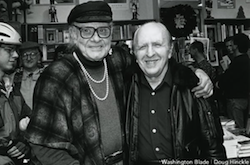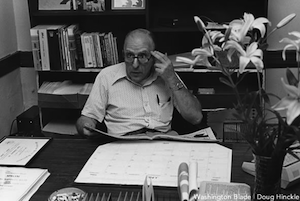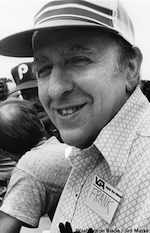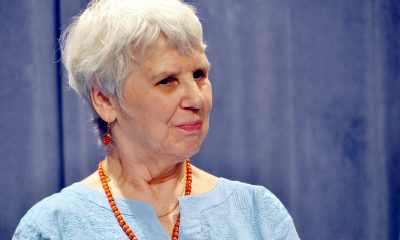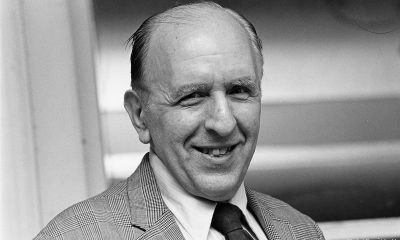Miscellaneous
Kameny in context
How will the trailblazer be remembered? And what is his rightful place in the pantheon of gay rights legends?
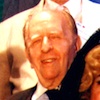
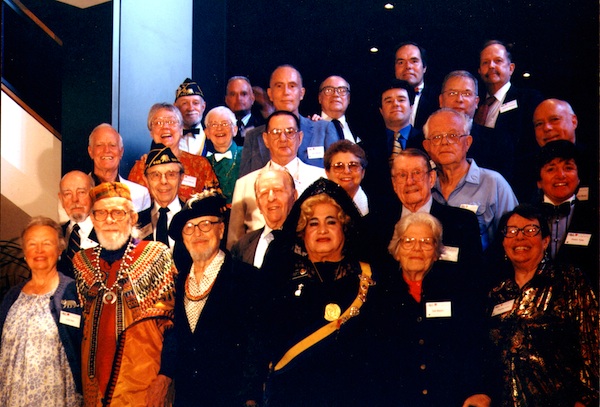
Frank Kameny among his colleagues in Los Angeles in 1998 to honor Jim Kepner and the 50th anniversary of the gay rights movement. First row from left are Lisa Ben, the late Harry Hay, the late John Burnside, Jose Sarria, the late Del Martin, Phyllis Lyon; (second row) Fred Frisbie, the late Bob Basker, Kameny, Florence Fleischman, the late Hal Call, Robin Tyler; (third row) the late Philip Johnson, Eddie Sandifer, the late Vern Bullough, Malcolm Boyd; (fourth row) the late Barbara Gittings, Kay Tobin Lahusen, the late Jack Nichols, Mark Segal, unidentified; (fifth row) the late Cliff Anchor, Leo Laurence, Eldon Murray, John O’Brien and Jerome Stevens. (Photo by Fred Camerer; reprinted with permission)
News outlets over the past week — both LGBT and mainstream — have reported the death of Frank Kameny, the legendary Washington-based activist universally regarded as one of the most influential pre-Stonewall homophile movement leaders.
Kameny died Oct. 11 at age 86 at his home in Northwest Washington and the news accounts have relayed oft-noted biographical facts that have taken on increasingly mythic proportions over the years: his firing from the Army Map Service in 1957 for being gay, the 1961 founding of the D.C. Mattachine Society, the “gay is good” slogan he coined, his role in convincing the American Psychiatric Association in 1973 to stop classifying homosexuality as a mental disorder, the Clinton-signed presidential executive order that permitted gay people to be given security clearances, the repeal of D.C.’s anti-sodomy law, his decades of work with the local Gay Activists Alliance (GAA; later GLAA) and more.
But once the dust settles — memorial services are planned for Washington and San Francisco on Nov. 15, the 50th anniversary of the founding of the D.C. Mattachine chapter — what will Kameny’s legacy be? Never one to shy away from taking credit, might his bluster and longevity have created a sense of myth about him? Or could his D.C. home base over so many years (he arrived here in 1956 and never left) have skewed perceptions of his efforts among local activists who may not be aware of the contributions of Kameny’s peers in other cities, especially on the West Coast? And where does Kameny fit in among other pioneering activists of his era? The Blade spoke to several gay historians, Kameny peers — both here and around the country — and friends to find out.
Kameny among peers
Kameny’s World War II-era generation is, of course, reaching its later years and many of the pre-Stonewall homophile activists — legendary figures such as Barbara Gittings, Harry Hay, Del Martin, Jim Foster, Jim Kepner, Jack Nichols and Hal Call — have died.
San Francisco’s Phyllis Lyon, who married her late partner Del Martin in 2008 after more than 50 years of joint activism, says she’s doing well (she’ll be 87 next month), still drives and has “no intention” of leaving her home, though life, obviously, has been a lot different since Martin’s 2008 death, just two months after they got married. She speaks highly of Kameny but admits to being fuzzy on specifics.
“Well, I think he did a lot of very good things, definitely,” she says. “I do remember Frank and I was very sorry to hear that he had died but it was different in those early days. I guess you could say the lesbians and gay men weren’t always buddy buddy buddy buddy back then. We worked together some, but in essence we also worked mostly with our own sexes.”
Things were somewhat different in Washington. Though she eventually moved on and did other things with her life, Lilli Vincenz, 73, was an early Washington-based activist who was in the Mattachine Society here and joined Kameny in his legendary White House protest in April 1965. She also knew — as did Lyon — the late Harry Hay, who started the first Mattachine Society in Los Angeles in 1950, which Kameny regarded as the start of the modern gay rights movement in the U.S. (a 1920s Chicago-based group was quickly shut down by police though a gay “emancipation group” started in 1897 in Berlin and lasted decades before being shut down by Hitler’s Nazi regime).
“Well, they had a slightly different approach,” Vincenz says of Hay and Kameny. “Frank was here taking advantage of Washington and being close to all the big government agencies, so that was his focus.”
Paul Kuntzler, who was just 20 when he met Kameny at the Chicken Hut in early 1962, was always “the kid” of the group. He says, as was Kameny’s contention, that the D.C. Mattachine Society was accomplishing things gays in other U.S. cities — chapters also existed in New York, Philadelphia, San Francisco and Los Angeles at the time — weren’t doing.
“A lot of them were just content to do more research and education,” Kuntzler says. “Originally I thought Harry Hay was very brave and I think originally they were very active, but they kind of got disinvolved.”
Kuntzler says it started with Hay’s group in 1950, the second wave was in Washington in the early ‘60s, then Stonewall, the 1969 New York riots that catapulted gay rights issues into the mainstream consciousness.
In Kuntzler’s estimation, Kameny is “the most influential and most important person in the history of the gay rights movement. The only other person I’d put in that league would be Barbara Gittings who died in February 2007. She was an intellectual heavyweight, but not quite up there with Frank. But she was very powerful and influential.”
San Francisco-based activist Michael Petrelis, who in 2009 launched an effort to have Kameny awarded a Congressional Medal of Honor, agrees. He lived from 1990-1995 in Washington and, though they sometimes clashed on issues of AIDS activism, saw Kameny as a grandfather of sorts.
“Some of my pushy personality, my pushy activism, comes from Frank,” Petrelis says.
Historical assessments
But how does Kameny’s legacy sit with gay historians? Depends whom one asks.
Gay scholar John Lauritsen, who wrote two essays for the 2002 anthology “Before Stonewall: Activists for Gay and Lesbian Rights in a Historical Context,” says Kameny should certainly be admired for his contributions but that he was only one type of activist whose efforts should be put in context. Lauritsen, during a phone chat from his Boston home, says he was active in the homophile movement since 1960 and knew Kameny and Gittings in the ‘70s when they would meet at various conferences.
“Our politics were much different,” Lauritsen says. “I was much more radical. But Frank was always friendly to me … I would say I admired Kameny. He was a very good public speaker … but I think one has to give credit to the scholars and Kameny was not a scholar … I think he was more a good publicist perhaps. I’m not sure he really did invent the saying ‘gay is good,’ that’s been debated, but at least it was a catchy slogan and it played a role in the movement at the time.”
Kameny could be a polarizing figure. Though even his detractors in the gay world eventually came to mostly acknowledge his accomplishments, in the early years there was much debate about the appropriate plan to gain traction with the movement.
“In those days, people felt he was rather reckless and far too militant,” says writer David Carter who interviewed Kameny about 45 times over the last several years for a biography he hopes to publish. “It’s funny though, after Stonewall, he was held up as a symbol of not being militant enough but that was more of a caricature of Frank.”
Michael Bronski, whose book “A Queer History of the United States” came out in May, teaches women, gender and LGBT studies at Dartmouth. He praises Kameny’s work but agrees, Kameny wasn’t working alone and it’s important to remember others.
“It’s vitally important to remember Frank and to give him credit for all this, but the ‘50s were really an incredible time … It’s unfair, I agree, to try to rank people mostly, unless the ranking happens by simply looking at the facts, but does the average gay person reading the Advocate really know who Harry Hay was or who Harvey Milk was? They think of Sean Penn or they might say, ‘Harvey Milk, wasn’t he married to Madonna in the ‘80s?’ Not knowing about Frank is a huge loss and it’s a loss that needs to be corrected. But I don’t think this is just an LGBT problem, it’s an American problem in general.”
Bronski is quick to point out, though, that Kameny is part of a small list of pre-Stonewall iconoclasts.
“Harry Hay, Del and Phyllis, Barbara Gittings — there aren’t many whose names come to the forefront because a lot of the work (others) did was very quiet, so somebody like, say, Randy Wicker, who founded the Oscar Wilde bookstore and the Mattachine Society in New York before Stonewall, that was a different kind of a thing.”
Paul Boneberg, executive director of the San Francisco-based GLBT Historical Society, is more unequivocal.
“There is no greater gay activist than Frank Kameny,” Boneberg says. “He is one of the heroic founders of the modern era.”
Boneberg agrees with Bronski — the pre-Stonewall movers and shakers list is quite small.
“He’s part of a very small group,” Boneberg says. “He and a few of the early activists really founded the GLBT movement and the community is what it is because of people like Frank and what’s extraordinary is that his work in the ’50s and ‘60s continued right up until this year. It was really a lifetime of service to the queer community. … What we’re seeing is the passing of the queer community’s greatest generation. That World War II generation that he was part of. He was just an extraordinary individual and it’s a great loss to the community.”
Malcolm Lazin, executive director of the Equality Form and executive producer of the PBS documentary “Gay Pioneers, unequivocally this week called Kameny “the father of the LGBT civil rights movement” in a press release. The term hasn’t been widely used but may become more common as Kameny’s contributions are assessed.
And where might LGBT rights be today if Kameny hadn’t done what he did?
“I think on one level, what Frank did moved us ahead incredibly far,” Bronski says. “But if Frank didn’t exist, would somebody else have done it? Possibly. You know Frank wasn’t the only person to get arrested and lose his job. It’s conceivable and actually likely that somebody else would have had the courage to do that, but in no way do I say that to diminish what he did, but did the movement depend on Frank? I don’t think so. Did Frank move the movement forward? Sure.”
Kameny on Kameny
And what did Kameny himself think of his place in the history books? Outtakes from an Aug. 16 interview pertaining to the push for a presidential Medal of Freedom for him, found him waxing nostalgic for several of his peers.
“Just about all these people are gone,” Kameny said. “One of the first I would name would be Barbara Gittings, whom I miss very, very much. Another would be Jack Nichols. One by one they have all gone.”
Kameny also mentioned several activists whose work has been more D.C.-centric.
“On much less a level, but still someone who goes all the way back would be Craig Howell and coming much later onto the scene and I first got to know him in college in the ‘70s and ‘80s, but I would also say Rick Rosendall. That’s just off the top of my head. Many of them have just all died off one after another and I’m very, very sorry to see some of them go, but that happens.”
Kameny phoned the next morning to say he was “embarrassed I overlooked Paul Kuntzler. He goes back to the very beginning of my involvement in 1961 right after we formed the Mattachine Society … he was perhaps the last one going back to the ‘60s who’s still around.”
Comparing Kameny’s life and work to Harvey Milk’s — the first openly gay man to be elected to public office when he won a seat on the San Francisco Board of Supervisors — is apples and oranges, many say. If Milk’s story is more widely known, it’s undoubtedly because it’s been told several times, most memorably, perhaps, in a 2008 Academy Award-winning film. That he died young (he was murdered at age 48) perhaps gave him a JFK-like stature among gays that captured their consciousness.
“They were just from very different times,” Boneberg says. “Harvey is separated almost a whole generation and he would have acknowledged that. … It’s hard for people today to imagine how difficult it was to stand up and be out back then. Time is such a huge factor. That first generation stood alone and said, ‘I will not take this.’ Frank did that. [Drag legend] Jose [Sarria] did that. It’s just something later people have not had to do because there were already other people standing. It’s very hard for people to grasp. There were profound legal consequences and people who were gay were literally destroyed.”
Even Cleve Jones, a friend and contemporary of Milk and an activist in his own right, says their lives are too different to warrant much comparison.
“Harvey and all of us who came after the Stonewall rebellion, all of us were marching down a road that had already been paved by people like Frank, Barbara [Gittings], Phyllis and Del … the Stonewall generation was still in the closet when Frank was doing his work, so you can’t really compare them.”
Choices made
Milk, of course, suffered. But those close to him say Kameny suffered in other ways — less dramatic, but also difficult.
“He lived in poverty,” Kuntzler says. “He got some inheritance money from his mother and he eventually bought [his] house, but it was a struggle. I gave him money for his fax machine. People helped him out, but he lived basically in poverty, there’s no question about it.”
Marvin Carter, a local gay volunteer with Helping Our Brothers and Sisters who’d known Kameny for years, started helping him the winter before last during several extreme blizzards the region suffered.
“There’d been a few calls here and there before, but that’s when we really started to see the extent of the situation,” Carter says. “He was snowed in and had no groceries. … It was really a bad situation.”
But was some of that by choice? Obviously in recent years Kameny was elderly, but why didn’t he work much — at least for income — in the ‘70s and ‘80s? Couldn’t he have secured a position doing the work he loved for an organization like Human Rights Campaign or National Gay & Lesbian Task Force?
Kuntzler says Kameny was “very stubborn” and single minded in his activist philosophies.
“He was very independent, very much his own person. It would have been very hard for him to acquiesce to someone else’s vision,” Kuntzler says. “He absolutely sacrificed.”
Bronski agrees, but with a caveat.
“Yes, he made that sacrifice, but it’s important to remember that he made it on his own. There wasn’t a vote on it. We should all be thankful and we can’t expect other people to do the same. It’s a matter of self sacrifice, but yes, from what I’ve heard he did actually live in fairly impoverished conditions.”
Time, of course, has a way of putting individuals’ contributions into perspective. In the meantime, Kameny’s colleagues are remembering him fondly.
“In my opinion, his legacy is already established,” Vincenz says. “He was a tutor to me and I was very thrilled to work with him. … I saw him as a zealot, very effective. He also had such a kind heart. I was reading not long ago his lovely eulogy to Barbara and it was just beautiful.”
Kuntzler remembers a rabble-rouser who “delighted in antagonizing.”
“He was never violent, it was all intellectual,” he says. “And he was very self assured. He didn’t question it at all. He truly felt that he was right and they were all wrong.”
Miscellaneous
What it means to be an active ally to your LGBTQ+ co-workers TEST
Five easy tips to help you avoid common risks
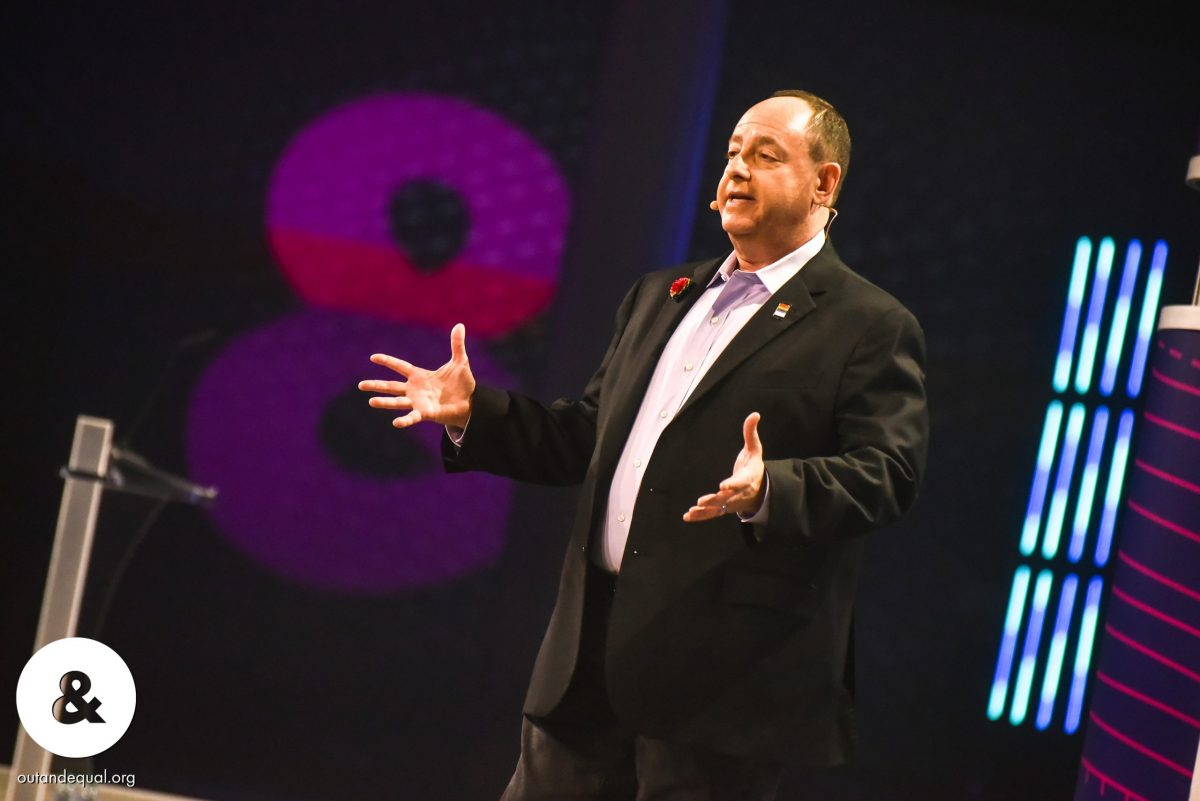
Your home is more than just a place to eat and sleep; it’s your safe haven. As much as you might cherish your home, you should probably also recognize the potential hazards within its familiar walls. Accidents can happen in an instant, yet with a little foresight and some simple adjustments, you can transform your house into a safer haven.
Accidents can happen anywhere, and with a few simple tweaks, you can lower risks in your space. Below you’ll find five tips for each room in your home to help prevent injuries, falls, and other mishaps. In short, home safety.
This article was inspired by a shower in a rental we managed that began leaking through the kitchen ceiling below. If only the landlord had installed grab bars, right!? Below, we’ll guide you through the steps to fortify your bathroom, making it a place of relaxation without the fear of slips and falls. Then, we’ll venture into the room where the magic happens, where proper planning can ensure great nights and peaceful mornings. We’ll show you how to prevent accidents while you experiment becoming the next Gordon Ramsey. And we’ll include a few surprising solutions for those other rooms that hold their own unique hazards, offering solutions to safeguard against unexpected mishaps.
Bathroom Safety
Install Grab Bars: Adding grab bars near the shower and toilet can provide essential support for family members of all ages. Not only can they help with getting in and out, but they can help provide stability when washing. Make sure they are securely anchored to the wall.
Non-Slip Mats: Place non-slip mats inside the shower and bathtub to prevent slips. They’re a small investment that can save you from falls and head injuries.
Adjust Water Temperature: Ensure your hot water is set to a safe temperature to avoid scalding. The hot water heater should be set to around 120°F (49°C)l, the middle setting on many water heater settings.
Medicine Cabinet Locks: If you have young children, use childproof locks on your medicine cabinet to keep harmful substances out of reach.
Proper Lighting: Ensure there’s adequate lighting in the bathroom to avoid trips and falls during nighttime visits. Nightlights can be a simple and effective solution.
Bedroom Safety
Clear Pathways: Keep pathways in the bedroom clutter free to prevent tripping. Ensure there’s enough space to move around comfortably, particularly getting around the bed. Be aware where all furniture is when walking around to avoid stubbed toes, particularly at night.
Secure Rugs: If you have throw rugs, use rug grippers or double-sided tape to keep them from slipping. Loose rugs are a common trip hazard.
Bed Rails: For anyone at risk of falling out of bed, consider installing bed rails to provide extra support and prevent falls.
Nightstands with Drawers: Opt for nightstands with drawers to keep essential items. This reduces the need to get out of bed at night, minimizing the risk of falls, as you race to grab what you need and not lose a moment’s rest.
Fire Safety: Install battery-operated smoke detectors in the bedrooms if there are none. Make sure to install them 36 inches away from an air vent or the edge of a ceiling fan. Also six inches away from the joint between the wall and ceiling. And test smoke detectors regularly.
Kitchen Safety
Non-Slip Flooring: Choose slip-resistant rugs in the kitchen, especially in areas where spills are common. Mats near the sink and stove can also help and you can often buy them fairly cheaply at Costco.
Childproof Cabinets: If you have little ones, use childproof latches on cabinets and drawers to prevent them from accessing potentially hazardous items.
Anti-tip brackets: Install an anti-tip bracket behind the range. These are often used when children are in the home. Although they are less likely to open the oven door and use it as a step stool to get to the stove-top, adults can also benefit from installing these.
Adequate Lighting: Proper lighting is crucial in the kitchen to avoid accidents. Under-cabinet lighting can illuminate work areas effectively.
Secure Heavy Items: Ensure heavy pots and pans are stored at waist level to prevent straining or dropping them from high shelves.
Sharp Object Storage: Keep knives and other sharp objects in a secure drawer or block. And handle all sharp items with extreme care, even when washing and drying. These steps reduce the risk of accidental cuts.
Other Safety Tips
Furniture Anchors: Secure heavy furniture, like bookshelves and dressers, to the wall to prevent tip-overs, especially if you have young children.
Adequate Outlets: Check for damaged outlets and replace them promptly. Avoid overloading circuits with too many devices. Install placeholder plugs in outlets to prevent young curious fingers (or tongues?) from going inside an electrical outlet.
Stair Gates: If your home has stairs, install safety gates at the top and bottom to prevent falls, especially if you have toddlers or pets to keep them off of the stairs when you cannot monitor them.
Emergency Escape Plan: Develop and practice an emergency escape plan with your family, including a designated meeting place outside.
Carbon Monoxide Detector: If your home burns any fossil fuels for heating or appliances, install carbon monoxide detectors in common areas of your home to detect this odorless gas. The D.C. building codes require this if you use a fireplace or if you have an attached garage. In essence, if there is any potential source of carbon monoxide in the home, be sure to install these detectors.
Remember, a safer home not only prevents accidents but also provides peace of mind for you and your family. Implement these simple tips to create a secure environment in every room of your house.
With these practical tips and a few adjustments, you can significantly reduce the risk of injuries and falls in your home. Enjoy peace of mind in your now much safer haven.
Scott Bloom is owner and senior property manager of Columbia Property Management.

When Lizzo sings “If I’m shinin,’ everybody gonna shine,” in her hit song, “Juice,” she means it. Proof of that came this week on Instagram when the LGBTQ ally announced the first winner of her annual Juneteenth Giveback Campaign is the Marsha P. Johnson Institute, a national nonprofit based in Richmond, Calif., dedicated to the protection and defense of Black transgender people.
And she did so in song: “On the first day of Juneteenth, Lizzo gave to me,” she sang in her video, posted Tuesday, as she revealed her $50,000 gift to MPJI.
“That’s right, we know who Marsha P. Johnson is. We know what Marsha P. Johnson has done for the LGBTQ, emphasis on that ‘T,’ Q community,” said Lizzo to her 13.5 million followers. “Thank you so much to the people at the Marsha P. Johnson Institute. You deserve this, and I hope this helps you so much as you help protect our Black trans family.”
“What the Marsha P. Johnson Institute does is protects and defends the rights of Black transgender people. They do this by organizing community, advocating for the people, and creating an intentional healing community, developing transformative leadership and promoting collective power,” she said.
“We are overjoyed for the shoutout from Lizzo today, the generosity of her sharing her platform and the recognition of MPJI and its work,” said Elle Moxley, MPJI’s executive director. “The resources from this campaign will ensure the protection and defense of Black transgender people continue at a time where it is so vitally needed. We are so grateful for the support of Lizzo and her fans.”
As one of Time Magazine’s Persons of the Year for 2019 and a 2023 Grammy winner, Lizzo is more than a pop star but an inspiration to millions of fans for her body-positive attitude, her self-confidence on stage and in her videos, her empowering music and her activism. She’s also the founder of her own clothing line, Yitty. In 2021, she made headlines when she publicly corrected a paparazzo for using “she/her” pronouns and misgendering Demi Levato.
As part of her campaign, now in its 4th year, Lizzo recognizes Black-led grassroots organizations and businesses and encourages her fans to join her in supporting each of the five organizations she highlights this week. Fans who take action by donating are entered into a drawing for an all-expenses paid trip to see her perform at Fuji Rock in Japan later this year.
This week’s other nonprofits receiving gifts are: Black Girls Smile, Sphinx Music, the University of Houston and Save Our Sisters United.
Find out more about Lizzo’s 4th annual Juneteenth Giveback Campaign by clicking here.
Celebrity News
Anne Heche dies after removal from life support
Actress dated Ellen DeGeneres in late 1990s

Actress Anne Heche died after she was removed from life support on Sunday, nearly two weeks after her Mini-Cooper crashed through a two-story house in Los Angeles’ Mar Vista neighborhood. Investigators with the Los Angeles Police Department believe she was intoxicated at the time.
She sustained a severe anoxic brain injury along with severe burns and was being treated at the Grossman Burn Center at West Hills Hospital, near Chatsworth in the San Fernando Valley.
The 53-year-old actress who was a star of films like “Donnie Brasco,” the political satire “Wag the Dog” and the 1998 remake of “Psycho,” had been declared legally dead under California law on Friday, however, her family kept her alive long enough to be an organ donor.
In a statement Friday, the LAPD announced that: “As of today, there will be no further investigative efforts made in this case. Any information or records that have been requested prior to this turn of events will still be collected as they arrive as a matter of formalities and included in the overall case. When a person suspected of a crime expires, we do not present for filing consideration.” LAPD detectives had previously made public that investigators into the crash found narcotics in a blood sample taken from Heche.
The actress’s family released a statement on Friday:
“Today we lost a bright light, a kind and most joyful soul, a loving mother, and a loyal friend. Anne will be deeply missed but she lives on through her beautiful sons, her iconic body of work, and her passionate advocacy. Her bravery for always standing in her truth, spreading her message of love and acceptance, will continue to have a lasting impact,” the statement added.
Heche was married to camera operator Coleman Laffoon from 2001 to 2009. The two had a son, Homer, together. She had another son, named Atlas, during a relationship with actor James Tupper, her co-star on the TV series “Men In Trees.”
Laffoon left a moving tribute on an Instagram reel in which he also gave an update on how their 20-year-old son Homer Laffoon is coping with the loss of his mother.
“I loved her and I miss her, and I’m always going to,” he said adding: “Homer is okay. He’s grieving, of course, and it’s rough. It’s really rough, as probably anybody can imagine. But he’s surrounded by family and he’s strong, and he’s gonna be okay.”
“Rest In Peace, Mom, I love you, Homer,” the actor’s 20-year-old son, Homer, said in a statement after Heche was declared legally dead on Friday.“ My brother Atlas and I lost our Mom,” read the statement. “After six days of almost unbelievable emotional swings, I am left with a deep, wordless sadness. Hopefully, my mom is free from pain and beginning to explore what I like to imagine as her eternal freedom. Over those six days, thousands of friends, family, and fans made their hearts known to me. I am grateful for their love, as I am for the support of my Dad, Coley, and my stepmom Alexi who continue to be my rock during this time. Rest In Peace Mom, I love you, Homer.”
Tupper, a Canadian actor who starred alongside Heche in “Men in Trees,” had a 13-year-old son, Atlas, with her. “Love you forever,” Tupper, 57, wrote on his Instagram post’s caption with a broken heart emoji, which shared an image of the actress from Men in Trees.
Between 1997 and 2000, Heche was also in a relationship with talk show host Ellen DeGeneres.
“This is a sad day,” DeGeneres posted on Twitter. “I’m sending Anne’s children, family and friends all of my love.” The year after her break-up with the comedian, in September 2001, Heche recounted in her memoir “Call Me Crazy,” about her lifelong struggles with mental health and a childhood of abuse.
KTLA’s entertainment reporter Sam Rubin noted that over the past two decades, Heche’s career pivoted several times. In 2017, she hosted a weekly radio show on SiriusXM with Jason Ellis called “Love and Heche.”
In 2020, Heche made her way into the podcast world. She launched “Better Together” which she cohosted alongside Heather Duffy Boylston. The show was described as a way to celebrate friendship.
She also worked in smaller films, on Broadway, and on TV shows. She recently had recurring roles on the network series “Chicago P.D.,” and “All Rise” and was a contestant on “Dancing with the Stars.”
People magazine reported that several of Heche’s acting projects are expected to be released posthumously.
These include “Girl in Room 13,” expected to be released on Lifetime in September, “What Remains,” scheduled to be released in 2023, and HBO Max TV series “The Idol,” created by Abel Tesfaye (The Weeknd) and Euphoria creator Sam Levinson.
In her Instagram post from earlier this year Heche stands between her sons Atlas, 13 and Homer, 20.

